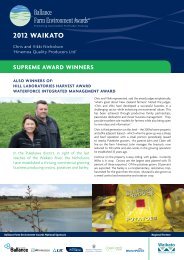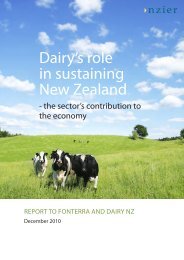NZIER report on compensation for transmission infrastructure
NZIER report on compensation for transmission infrastructure
NZIER report on compensation for transmission infrastructure
You also want an ePaper? Increase the reach of your titles
YUMPU automatically turns print PDFs into web optimized ePapers that Google loves.
There are a number of authors who argue that compensati<strong>on</strong> greater than<br />
equivalence of loss should be awarded (Beesley 2008; Hutchis<strong>on</strong> and Rowan-<br />
Robins<strong>on</strong> 2000; Hutchis<strong>on</strong> et al 1998), but much of the debate focuses <strong>on</strong> how to<br />
determine the financial equivalence of loss. Generally loss is calculated by<br />
c<strong>on</strong>sidering the area of the easement, market land values and factors such as lost<br />
revenue and additi<strong>on</strong>al operating expenses. These factors are covered separately<br />
below in 3.4.<br />
3.4 Standard features of compensati<strong>on</strong><br />
3.4.1 Easement area<br />
The area of an easement is central to compensati<strong>on</strong> calculati<strong>on</strong>s (easement area<br />
multiplied by land value usually accounts <strong>for</strong> a significant share of total<br />
compensati<strong>on</strong>). Within each easement some land is used exclusively by the utility<br />
and is typically compensated <strong>for</strong> at 100 percent of the land market value. The rest of<br />
the land is still able to be used <strong>for</strong> normal farming operati<strong>on</strong>s and is generally<br />
compensated <strong>for</strong> at less than 100 percent of land value. The extent to which the<br />
easement area can be used in a similar fashi<strong>on</strong> as surrounding land generally<br />
determines the degree of compensati<strong>on</strong>.<br />
The ground level dimensi<strong>on</strong>s of towers and other transmissi<strong>on</strong> structures, or the<br />
<strong>infrastructure</strong> „footprint‟, is c<strong>on</strong>sidered to be used exclusively by the utility (in practice<br />
an area slightly larger than the base of the <strong>infrastructure</strong> is usually included in the<br />
footprint <strong>for</strong> compensati<strong>on</strong> purposes). As far as we are aware, in all of the above<br />
countries compensati<strong>on</strong> <strong>for</strong> land which is used exclusively by the utility is at least 100<br />
percent of the market value of that area of land (see, <strong>for</strong> example, Hamer and<br />
O‟Brien 2007).<br />
Compensati<strong>on</strong> <strong>for</strong> the rest of the land needed <strong>for</strong> the easement is generally awarded<br />
at a percentage of the land market value of the total area. The corridor of land which<br />
transmissi<strong>on</strong> lines run over is often used in much the same manner as surrounding<br />
land, with crops or pasture grown under power lines. When there is little change to<br />
the earning capability of the land, utilities tend to pay <strong>on</strong>ly a share of the total land<br />
market value as compensati<strong>on</strong> (see, <strong>for</strong> example, Munneke and Trefzger 1998).<br />
A 1989 United Kingdom study found that temporary and permanent easement<br />
compensati<strong>on</strong> ranged from as little as 0 to as much as 100 percent of market land<br />
values, depending <strong>on</strong> how land could be used post the <strong>infrastructure</strong> being built<br />
(Corey 1989 in Munneke and Trefzger 1998). More recent studies suggest it is rare<br />
<strong>for</strong> compensati<strong>on</strong> to be less than 20 percent (see, <strong>for</strong> example, NFU 2009; Hydro-<br />
Québec 2000). One author discussed the use of a standard rule of thumb valuati<strong>on</strong><br />
of 25 percent of the quantity of land used <strong>for</strong> the easement (in the United States, see<br />
Munneke and Trefzger 1998). 14 Canada‟s Hydro-Québec provides compensati<strong>on</strong> at<br />
100 percent of the market value of the land covered by the easement, regardless of<br />
14 The authors argue against rule of thumb valuati<strong>on</strong>s as many relevant factors are ignored,<br />
including, <strong>for</strong> example, the n<strong>on</strong>-linear relati<strong>on</strong>ship between land value and parcel size.<br />
<str<strong>on</strong>g>NZIER</str<strong>on</strong>g> – Compensati<strong>on</strong> <strong>for</strong> transmissi<strong>on</strong> <strong>infrastructure</strong> 19
















